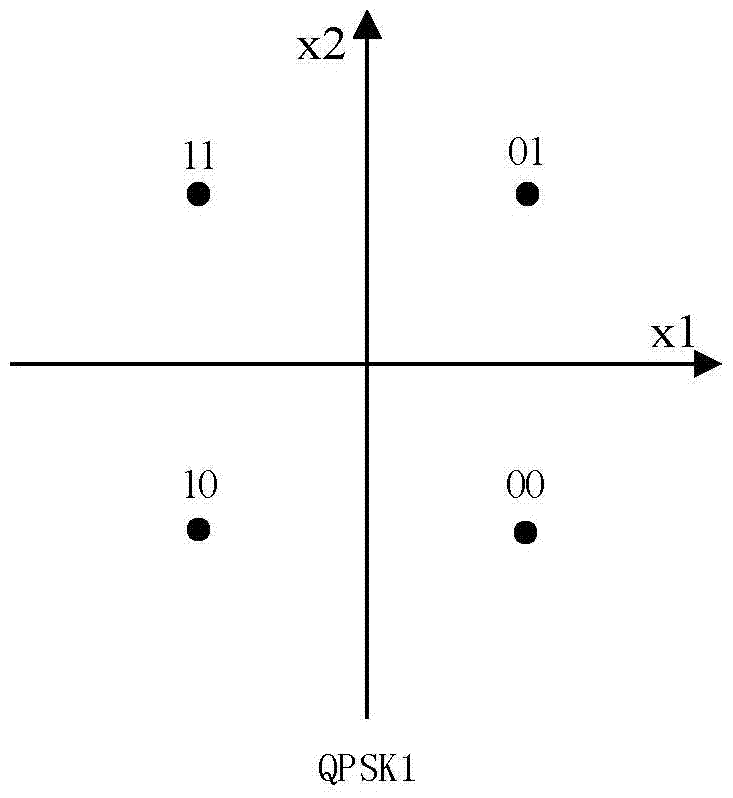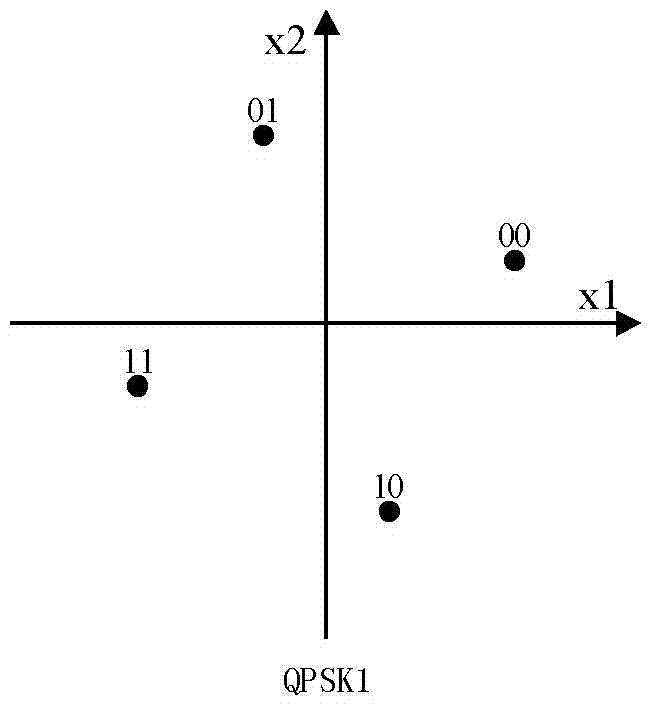A scma codebook search method based on maximizing the minimum product distance criterion
A technology of distance and product, which is applied in the field of SCMA codebook search based on maximizing the minimum product distance criterion, can solve the problem of codebook design difficulty and achieve the effect of small calculation, simple operation and guaranteed bit error rate performance
- Summary
- Abstract
- Description
- Claims
- Application Information
AI Technical Summary
Problems solved by technology
Method used
Image
Examples
specific Embodiment approach 1
[0029] Specific embodiment one: a kind of SCMA codebook searching method based on maximizing the minimum product distance criterion of this embodiment is specifically prepared according to the following steps:
[0030] Step 1. Draw two identical standard QPSK (Quadrature Phase Shift Keying) constellation diagrams, respectively QPSK1 (as shown in Figure 1(a)) and QPSK2 (as shown in Figure 1(b)), the power is a, That is, the distance from each constellation point to the origin is a; (the default power a of standard QPSK (visible in the reference book) is 1, and here I also directly specify it as 1, where the QPSK coordinates will be directly related to the 16-point coordinates obtained later. Because the 16-point coordinates are based on the QPSK coordinates) Among them, there are 4 constellation points in the QPSK constellation diagram, and the 4 constellation points are all on a circle, and the adjacent two constellation points of the 4 constellation points are respectively con...
specific Embodiment approach 2
[0059] Specific embodiment two: the difference between this embodiment and specific embodiment one is: the abscissa of the point in the SCMA constellation diagram of the first 16 points in the two corresponding 16-point SCMA constellation diagrams in step 3 is the first The first two bits B of the point in the 16-point SCMA constellation diagram 1 B 2 (B 1 B 2 Represents a point, such as the x1 axis coordinates in QPSK1 corresponding to 01) as shown in Figure 2(a); the ordinate of the point in the first 16-point SCMA constellation diagram is the point in the first 16-point SCMA constellation diagram last two bits B 3 B 4 The coordinates of the y1 axis corresponding to QPSK2 are shown in Figure 2(b). Other steps and parameters are the same as those in Embodiment 1.
specific Embodiment approach 3
[0060] Specific embodiment three: the difference between this embodiment and specific embodiment one or two is: the abscissa of the point in the SCMA constellation diagram of the second 16 points in the SCMA constellation diagram of two corresponding 16 points in step 3 is the first The first two bits B of the points in the two 16-point SCMA constellation diagrams 1 B 2 (B 1 B 2 Represents a point, such as the x2 axis coordinates in QPSK1 corresponding to 01) as shown in Figure 2(a); the ordinate of the point in the second 16-point SCMA constellation diagram is the point in the second 16-point SCMA constellation diagram last two bits B 3 B 4 The y2-axis coordinate corresponding to QPSK2 is shown in Figure 2(b). Other steps and parameters are the same as those in Embodiment 1 or Embodiment 2.
PUM
 Login to View More
Login to View More Abstract
Description
Claims
Application Information
 Login to View More
Login to View More - R&D
- Intellectual Property
- Life Sciences
- Materials
- Tech Scout
- Unparalleled Data Quality
- Higher Quality Content
- 60% Fewer Hallucinations
Browse by: Latest US Patents, China's latest patents, Technical Efficacy Thesaurus, Application Domain, Technology Topic, Popular Technical Reports.
© 2025 PatSnap. All rights reserved.Legal|Privacy policy|Modern Slavery Act Transparency Statement|Sitemap|About US| Contact US: help@patsnap.com



